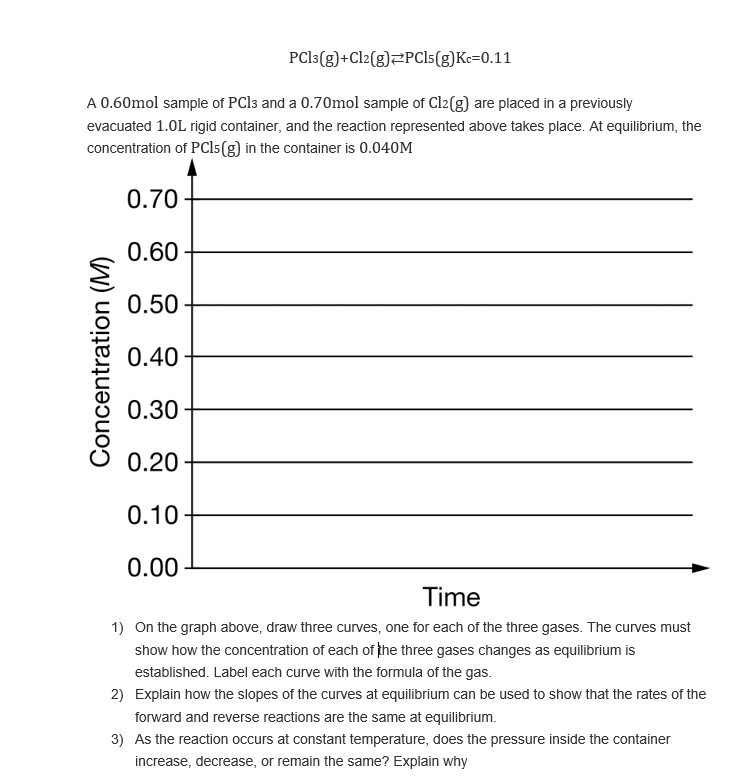PC13(g)+Cl2(g)ZPCI5(g)Kc=0.11 A 0.60mol sample of PC13 and a 0.70mol sample of Cl2(g) are placed in a previously evacuated 1.0L rigid container, and the reaction represented above takes place. At equilibrium, the concentration of PCI5(g) in the container is 0.040M 0.70 0.60 0.50 0.40 0.30 0.20 0.10 0.00 Time 1) On the graph above, draw three curves, one for each of the three gases. The curves must show how the concentration of each of the three gases changes as equilibrium is established. Label each curve with the formula of the gas. 2) Explain how the slopes of the curves at equilibrium can be used to show that the rates of the forward and reverse reactions are the same at equilibrium. 3) As the reaction occurs at constant temperature, does the pressure inside the container increase, decrease, or remain the same? Explain why Concentration (M)
PC13(g)+Cl2(g)ZPCI5(g)Kc=0.11 A 0.60mol sample of PC13 and a 0.70mol sample of Cl2(g) are placed in a previously evacuated 1.0L rigid container, and the reaction represented above takes place. At equilibrium, the concentration of PCI5(g) in the container is 0.040M 0.70 0.60 0.50 0.40 0.30 0.20 0.10 0.00 Time 1) On the graph above, draw three curves, one for each of the three gases. The curves must show how the concentration of each of the three gases changes as equilibrium is established. Label each curve with the formula of the gas. 2) Explain how the slopes of the curves at equilibrium can be used to show that the rates of the forward and reverse reactions are the same at equilibrium. 3) As the reaction occurs at constant temperature, does the pressure inside the container increase, decrease, or remain the same? Explain why Concentration (M)
Chemistry
10th Edition
ISBN:9781305957404
Author:Steven S. Zumdahl, Susan A. Zumdahl, Donald J. DeCoste
Publisher:Steven S. Zumdahl, Susan A. Zumdahl, Donald J. DeCoste
Chapter13: Chemical Equilibrium
Section: Chapter Questions
Problem 123CP: A sample of gaseous nitrosyl bromide (NOBr) was placed in a container tiued with a frictionless,...
Related questions
Question

Transcribed Image Text:PCI3 (g)+Cl2(g)2PCI5(g)Kc=0.11
A 0.60mol sample of PC13 and a 0.70mol sample of Cl2(g) are placed in a previously
evacuated 1.0L rigid container, and the reaction represented above takes place. At equilibrium, the
concentration of PC15(g) in the container is 0.040M
0.70
0.60
0.50
0.40
0.30
0.20
0.10
0.00
Time
1) On the graph above, draw three curves, one for each of the three gases. The curves must
show how the concentration of each of the three gases changes as equilibrium is
established. Label each curve with the formula of the gas.
2) Explain how the slopes of the curves at equilibrium can be used to show that the rates of the
forward and reverse reactions are the same at equilibrium.
3) As the reaction occurs at constant temperature, does the pressure inside the container
increase, decrease, or remain the same? Explain why
Concentration (M)
Expert Solution
This question has been solved!
Explore an expertly crafted, step-by-step solution for a thorough understanding of key concepts.
This is a popular solution!
Trending now
This is a popular solution!
Step by step
Solved in 4 steps with 1 images

Knowledge Booster
Learn more about
Need a deep-dive on the concept behind this application? Look no further. Learn more about this topic, chemistry and related others by exploring similar questions and additional content below.Recommended textbooks for you

Chemistry
Chemistry
ISBN:
9781305957404
Author:
Steven S. Zumdahl, Susan A. Zumdahl, Donald J. DeCoste
Publisher:
Cengage Learning

Chemistry: An Atoms First Approach
Chemistry
ISBN:
9781305079243
Author:
Steven S. Zumdahl, Susan A. Zumdahl
Publisher:
Cengage Learning


Chemistry
Chemistry
ISBN:
9781305957404
Author:
Steven S. Zumdahl, Susan A. Zumdahl, Donald J. DeCoste
Publisher:
Cengage Learning

Chemistry: An Atoms First Approach
Chemistry
ISBN:
9781305079243
Author:
Steven S. Zumdahl, Susan A. Zumdahl
Publisher:
Cengage Learning


Chemistry: Principles and Reactions
Chemistry
ISBN:
9781305079373
Author:
William L. Masterton, Cecile N. Hurley
Publisher:
Cengage Learning

Principles of Modern Chemistry
Chemistry
ISBN:
9781305079113
Author:
David W. Oxtoby, H. Pat Gillis, Laurie J. Butler
Publisher:
Cengage Learning

Chemistry & Chemical Reactivity
Chemistry
ISBN:
9781133949640
Author:
John C. Kotz, Paul M. Treichel, John Townsend, David Treichel
Publisher:
Cengage Learning